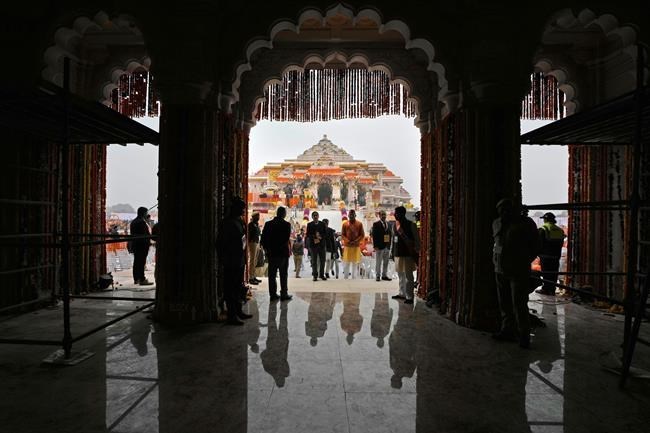AYODHYA, India (AP) — Indian Prime Minister Narendra Modi on Monday opened a controversial Hindu temple built on the ruins of a historic mosque in the northern city of Ayodhya, delivering on a crucial Hindu nationalist pledge that his governing party hopes will catapult him to a record third successive term in upcoming elections.
The temple, which is still under construction, is dedicated to Hinduism’s Lord Ram and fulfills a long-standing demand by millions of Hindus who worship the revered deity. Modi’s party and other Hindu nationalist groups who seized on the demand have portrayed the temple as central to their vision of reclaiming Hindu pride, which they say was shadowed by centuries of Mughal rule and British colonialism.
Modi, dressed in a traditional kurta tunic, led the opening ceremony as Hindu priests chanted hymns inside the temple’s inner sanctum, where a 1.3-meter (4.3-foot) stone sculpture of Lord Ram was installed last week. A conch was blown by a priest to mark the temple’s opening and Modi placed a lotus flower in front of the black stone idol, decked in intricate gold ornaments and holding a golden bow and arrow.
Millions of Indians watched the ceremony on television, with news channels running non-stop coverage of the event, portrayed as a religious spectacle.
Nearly 7,500 people, including elite industrialists, politicians and movie stars, witnessed the ritual on a giant screen outside the temple as a military helicopter showered flower petals.
Ayodhya, once crowded with tightly packed houses and rundown stalls, has undergone an elaborate makeover in the lead up to the temple's 0inauguration. Narrow roads have been turned into a four-lane pilgrimage route leading to the temple, tourists are arriving at a new airport and sprawling railway station, and major hotel chains are building new properties.
Jubilant devotees from across the country have arrived to celebrate the opening, with groups of them dancing to religious songs that blare from speakers on roads bedecked with flowers. Huge cut-outs of Lord Ram and billboards of Modi are ubiquitous across Ayodhya, where the borders have been sealed to prevent more people from coming in. Some 20,000 security personnel and more than 10,000 security cameras have been deployed.
Harish Joshi arrived in Ayodhya from Uttarakhand state four days before the ceremony, hopeful that he could get a glimpse of it. “I am here to see history unfolding before our eyes. For centuries, the story of Lord Ram has resonated in the hearts of millions," he said.
Analysts and critics see Monday’s ceremony as the start of the election campaign for Modi, an avowed Hindu nationalist and one of India’s most consequential leaders who has sought to transform the country from a secular democracy into a distinctly Hindu state in his nearly 10 years in power.
The temple, located at one of India’s most vexed religious sites, is expected to embolden Modi’s chances of clinching a record third successive term by drawing on the religious sentiments of Hindus, who make up 80% of India’s population of 1.4 billion.
Built at an estimated cost of $217 million and spread over nearly 3 hectares (7.4 acres), the temple lies atop the debris of the 16th-century Babri Mosque, which was razed to the ground in 1992 by Hindu mobs who believed it was built on temple ruins marking the birthplace of Lord Ram.
The site has long been a religious flashpoint for the two communities, with the demolition of the mosque triggering bloody riots across India that killed 2,000 people, mostly Muslims.
The dispute ended in 2019 when, in a controversial decision, India’s Supreme Court called the mosque’s destruction “an egregious violation” of the law but granted the site to Hindus while giving Muslims a different plot of land.
The fraught history is still an open wound for many Muslims, who see the construction of the temple as a testament to Modi’s Hindu-first politics.
Officials say the temple, a three-story structure made of pink sandstone, will open to the public after the ceremony and they expect 100,000 devotees to visit daily. Builders are still working to finish 46 elaborate doors and intricate wall carvings.
The inauguration has morphed into a massive national event.
Modi’s government planned live screenings across the country and even movie theaters in some cities showed the event while offering free popcorn. Governing party workers have gone door to door handing out religious flags, while Modi encouraged people to celebrate by lighting lamps at homes and in local shrines. Government offices were closed for half a day on Monday, and many states declared it a public holiday. Even the stock and money markets were closed for the day.
But not all are rejoicing. Four key Hindu religious authorities refused to attend, saying consecrating an unfinished temple goes against Hindu scriptures. Some top leaders from India’s main opposition Congress party are also boycotting the event, with many opposition lawmakers accusing Modi of exploiting the temple for political points.
___
Saaliq and Pathi reported from New Delhi.
Biswajeet Banerjee, Sheikh Saaliq And Krutika Pathi, The Associated Press


